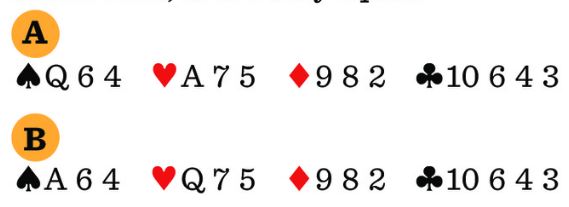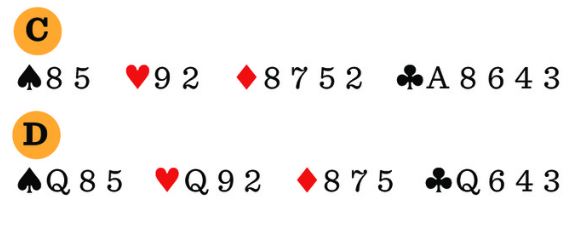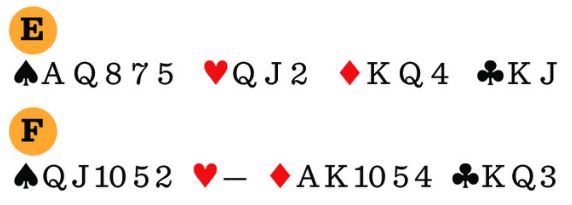Good hand evaluation involves a lot more than mechanically counting points.
Source: January 2015 ACBL Bridge Bulletin 



Any reader of my articles knows all about counting points, but a separate vital question is,
“What is my hand worth?”. Begin with the premise that not all high-card points are equal. For instance, partner opens 1

and right-hand opponent passes.
Which of the following 6-HCP hands would you rather hold, or are they equal?
 B
B is better than A because both your honor cards are “working”: They will help take tricks. The

Q in the first hand may be a wasted value, but the

Q in B is will be useful.
The lesson: It is better to hold secondary honors inside partner’s suit and aces outside, rather than the opposite.
Try another. LHO opens 1

, partner intervenes with 1

and RHO passes. Which of these hands is more valuable?

C is far preferable because those distributional values are apt to help partner in a diamond contract. The  A is pure, and both doubletons will limit partner’s major-suit losers, particularly in combination with the fourth diamond. Partner can draw trumps and still have diamonds in dummy to ruff losers. Just as secondary honors may be wasted when they don’t help win a trick, shortness may be wasted if each partner holds, say, a doubleton in the same suit.
A is pure, and both doubletons will limit partner’s major-suit losers, particularly in combination with the fourth diamond. Partner can draw trumps and still have diamonds in dummy to ruff losers. Just as secondary honors may be wasted when they don’t help win a trick, shortness may be wasted if each partner holds, say, a doubleton in the same suit.
In this auction, neither opponent has shown a major, so partner is likely to hold at least a tripleton in each major. Your doubletons are well located. While D has a higher point count, it has far less value. At least one of the queens may be wasted, and the flat distribution doesn’t help declare a diamond contract.
I would preempt to 3

holding C and pass with D.
In the next example, you open 1

and partner raises to 3

,10-12 points and at least four trumps. Which of the following two hands contains more slam potential?
 E
E has 18 HCP and F has 15, but F might even produce a grand slam while E is worth no more than game. If this isn’t clear, start thinking in terms of tricks. Note the top-card losers with E: one spade, two hearts, one diamond and at least one club. How likely is it that partner can cover four of your five losers holding a maximum of 12 points? If partner holds three aces, you still need either the heart or spade finesse. Plus there’s the possible nuisance of a missing

J or a third-round heart loser. Even 5

could come to grief if the opponents can cash a red ace and two clubs, or a singleton is on lead.
Now, consider hand F. An ideal dummy such as:

yields a probable spade grand slam. Numerous other hands make 6

a fine contract; the key is whether partner holds wasted values in hearts.
Holding E, sign off in 4

. Holding F, make a slam try by showing your diamond control (4

). Even if partner signs off with 4

, another slam try -5

– is in order. In the control bidding style where first-round controls are shown ahead of second, 5

shows second-round club control. You would have bid 4

holding both first-round minor-suit controls. Partner didn’t cuebid 4

which is good news, suggesting that his values may usefully mesh with your suits.
Good hand evaluation involves a lot more than mechanically counting points.
 B is better than A because both your honor cards are “working”: They will help take tricks. The
B is better than A because both your honor cards are “working”: They will help take tricks. The 
![]() A is pure, and both doubletons will limit partner’s major-suit losers, particularly in combination with the fourth diamond. Partner can draw trumps and still have diamonds in dummy to ruff losers. Just as secondary honors may be wasted when they don’t help win a trick, shortness may be wasted if each partner holds, say, a doubleton in the same suit.
A is pure, and both doubletons will limit partner’s major-suit losers, particularly in combination with the fourth diamond. Partner can draw trumps and still have diamonds in dummy to ruff losers. Just as secondary honors may be wasted when they don’t help win a trick, shortness may be wasted if each partner holds, say, a doubleton in the same suit. E has 18 HCP and F has 15, but F might even produce a grand slam while E is worth no more than game. If this isn’t clear, start thinking in terms of tricks. Note the top-card losers with E: one spade, two hearts, one diamond and at least one club. How likely is it that partner can cover four of your five losers holding a maximum of 12 points? If partner holds three aces, you still need either the heart or spade finesse. Plus there’s the possible nuisance of a missing
E has 18 HCP and F has 15, but F might even produce a grand slam while E is worth no more than game. If this isn’t clear, start thinking in terms of tricks. Note the top-card losers with E: one spade, two hearts, one diamond and at least one club. How likely is it that partner can cover four of your five losers holding a maximum of 12 points? If partner holds three aces, you still need either the heart or spade finesse. Plus there’s the possible nuisance of a missing 
























